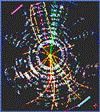Department of Physics and Astronomy: Publications and Other Research
Document Type
Article
Date of this Version
10-14-2004
Abstract
For comparison of inclusive jet cross sections measured at hadron-hadron colliders to next-to-leading order (NLO) parton-level calculations, the energy deposited in the jet cone by spectator parton interactions must first be subtracted. The assumption made at the Tevatron is that the spectator parton interaction energy is similar to the ambient level measured in minimum bias events. In this paper, we test this assumption by measuring the ambient charged track momentum in events containing large transverse energy jets at √s =1800 GeV and √s =630 GeV and comparing this ambient momentum with that observed both in minimum bias events and with that predicted by two Monte Carlo models. Two cones in η-Φ space are defined, at the same pseudorapidity, η, as the jet with the highest transverse energy (ET(1)), and at ±90° in the azimuthal direction, Φ. The total charged track momentum inside each of the two cones is measured. The minimum momentum in the two cones is almost independent of ET(1) and is similar to the momentum observed in minimum bias events, whereas the maximum momentum increases roughly linearly with the jet ET(1) over most of the measured range. This study was carried out using data from the CDF detector taken during Run 1 (1994-1995). The study will help improve the precision of comparisons of jet cross section data and NLO perturbative QCD predictions. The distribution of the sum of the track momenta in the two cones is also examined for five different ET(1) bins. The HERWIG and PYTHIA Monte Carlo generators are reasonably successful in describing the data, but neither can describe completely all of the event properties.


Comments
Published by American Physical Society. Phys. Rev. D 70, 072002 (2004). http://prd.aps.org. Copyright © 2004 American Physical Society. Permission to use.